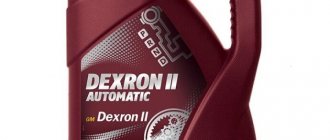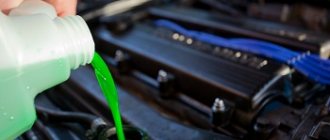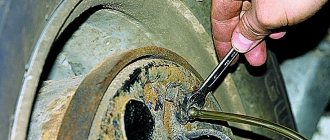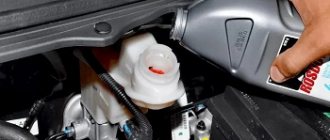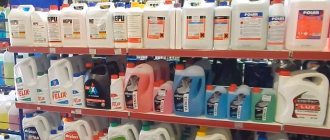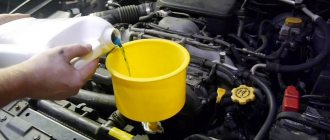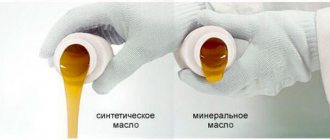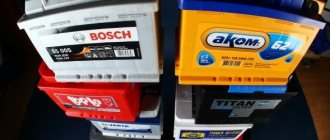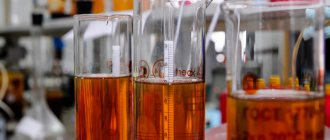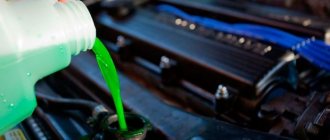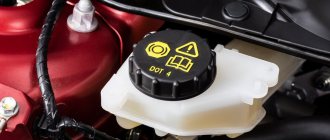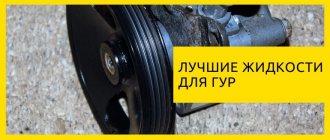Often motorists themselves do not know what kind of fluid is in the brake system reservoir. And when the need for topping up arises (after repairs or when bleeding the brakes), a logical question arises: what, exactly, is in the tank, and what can it be mixed with? Below we will try to briefly answer the question: is it possible to mix brake fluid from different manufacturers?
Classification of brake fluid.
There are several systems for dividing brake fluids: according to viscosity, according to DOT standards, boiling point. In addition, there are generally accepted standards - SAE J 1703, ISO 4925, etc.
The most common of them is gradation according to DOT standards, it consists of:
DOT3 (glycolic)
Recommended for classic cars with front brakes and rear drums.
Main characteristics:
- the boiling point in the “dry” state is not less than 205 degrees, in the “moistened” state (contains 3.5% water) - not less than 140 degrees;
- viscosity at negative temperatures (-40 degrees) – not less than 1500 mm2/s.
DOT4 (glycolic)
Used for modern vehicles with disc brakes on both axles.
Main characteristics:
- the boiling point in the “dry” state is not less than 230 degrees, in the “moistened” state (contains 3.5% water) - not less than 155 degrees;
- viscosity at negative temperatures (-40 degrees) – not less than 1800 mm2/s.
DOT5 (silicone) and DOT5.1 (glycolic)
It is used on sports cars with a fairly high temperature load.
Main characteristics:
- the boiling point in the “dry” state is not less than 260 degrees, in the “moistened” state (contains 3.5% water) - not less than 180 degrees;
- viscosity at negative temperatures (-40 degrees) – not less than 900 mm2/s.
Interchangeability of different brands
Recommendation one: topping up brake fluid made on a different base is unacceptable and dangerous to the lives of vehicle passengers. That is, silicone or BSA cannot be added to the glycol composition and vice versa.
What is the danger: the consequences do not appear immediately, but after some time, until the material is mixed and heated as a result of the brakes being applied. A precipitate forms in the mixture and dense clots form, blocking the normal operation of the system - the brakes fail. In the best case, you will have to empty all the cylinders and pipes for thorough washing.
Now about whether it is possible to add liquid made on the same basis. It is quite permissible to dilute the glycol composition with a similar material, but with reservations:
- It is allowed to mix glycol fluids DOT 3, 4 and 5.1 with each other, DOT 5 is a silicone material, it cannot be added.
- If you added a glycol composition with a lower boiling point, for example, DOT 3, to the fourth series fluid, the brake system is not in danger, but upon arrival at the garage it is recommended to change the working environment. The reason is the deterioration of the properties of the mixture due to the addition of low-grade material.
- After adding a higher class fluid, for example, the 5.1 series to the DOT 3 composition, the temperature characteristics of the mixture will improve. It is not necessary to completely change the fluid in the brake system, unless you notice suspicious deviations - pedal failures or a weak response to its pressing.
Advice. It is recommended to add brake fluid on the road only after eliminating a leak or problem causing loss of brake fluid. The exception is a minor leak, where liquid escapes in small quantities.
Like glycol, silicone compounds are also interchangeable because they are made on the same basis. The boiling point of DOT 5 and DOT 5.1/ABS is identical - 260 °C (wet material - 180 °C). There is a limitation here: it is highly undesirable to add Series 5 fluid to cars equipped with an ABS anti-lock braking system; only the “native” material is DOT 5.1/ABS.
If you find yourself in a hopeless situation and still fill the expansion tank of a car with ABS with Series 5 compound, empty the system as soon as possible when you get to a garage or car service center. The additive will not lead to an emergency and will not cause significant harm to the parts, but will shorten the service life of the rubber elements.
We recommend: Why the VAZ-2115 instrument panel does not work: repair
Classification of bunkers
What elements are included in brake fluids, their properties, markings - all these parameters need to be paid attention to when purchasing this or that composition. Therefore, it is worth learning more about the classification of “dotov” compositions.
Initially, the abbreviation DOT looked like USDOT and stood for United States Department of Transportation, which translates as the US Department of Transportation. As you may have guessed, this institution is responsible for the safety of vehicles. The same Department created a specification for the requirements and properties of brake fluids, and also divided several FMVSS No. 116 standards and assigned them the name DOT. This means that DOT is not the name of the liquid, but an international standard, according to which any company can be the manufacturer of this product.
Interesting! International standards such as SAE J 1703 and ISO 4925 appeared much later.
Based on this, the following compositions emerged:
DOT 3
This brake fluid is based on the simplest glycol compounds (polyethylene glycol and polyethers), and therefore its cost is an order of magnitude lower. This, of course, makes DOT 3 very popular among car enthusiasts. Like all liquids made on the basis of glycols, compositions of this class absorb moisture very quickly, and therefore their boiling point decreases over time. Because of this, DOT 3 does not have a long service life, and such a “brake guard” will have to be changed every 2 years.
Healthy! DOT 3 fluids are not compatible with natural rubber, which is what brake pads are often made from. In addition, the compositions are aggressive to paint and varnish coatings.
It is also worth noting that the viscosity of such liquids is not so much - 1500 mm2/s at -40 degrees. DOT 3 compounds are used for brake systems of vehicles equipped with drum brakes. The fluid is also suitable for disc brakes located on the front wheels.
DOT 4
DOT 4 fluids have better performance. In addition to glycols, they contain boric acid, due to which excess moisture in the composition is neutralized. This means that the boiling point of DOT 4 is stable and does not decrease during vehicle operation. However, the viscosity of this composition is the highest among other “pillboxes”. Therefore, it is impossible to say she is the best. In addition, the shelf life of DOT 4 brake fluid also does not exceed 2 years. In addition, the composition of this class also acts aggressively towards paint.
Healthy! On the shelves of domestic stores you can find compounds labeled DOT 4.5 or DOT 4+. There are no such classifications in the American system, so be careful.
However, Dot 4 brake fluid, whose technical characteristics are not ideal, is in great demand among owners of cars equipped with disc brakes.
DOT 5
If we talk about which brake fluid is better, then the most durable is the “Dotov” composition DOT 5. The fact is that it is made on the basis of silicone, which is characterized by its weak hygroscopicity. Thanks to this, the service life of DOT 5 is 4-5 years. The remaining characteristics of the liquid are also close to ideal. Among the advantages it is worth mentioning stable viscosity, high boiling point and much more. In addition, the composition repels moisture and behaves neutrally in relation to rubber elements or paint coatings.
But in every barrel there is a fly in the ointment. The ability to repel excess water will have to be attributed to the disadvantages of DOT 5, since excess moisture does not mix with the liquid, but gradually accumulates in the lower sections of the brake system. As a result, the resulting water "apendix" freezes in winter and interferes with the operation of the system. Another problem with DOT 5 is the high degree of aeration, that is, air saturation. That is why such fluids are strictly prohibited for use in cars with ABS. Well, for those who, as luck would have it, are the owners of just such machines, a special composition was developed.
DOT 5.1/ABS
Liquids of this class are made on the basis of glycols, but, in addition, they contain a large number of additional additives. Thanks to this, DOT 5.1 has a high boiling point, low viscosity and neutrality towards rubber gaskets. However, such compositions still corrode the paint.
Such brake fluids circulate freely throughout the system, improving the performance of the brakes themselves. Due to these properties, DOT 5.1 compounds are used for racing cars, sports cars and motorcycles. The service life of such a liquid is 3-4 years.
With the advent of all these classifications, a completely logical question arises - what will happen if you mix different classes of liquids?
Is it possible to mix different types of brake fluid?
In old cars, BSK brake fluid was once used; it was red in color - the dye was added to it specifically so that fluid leakage could be determined by its color. Modern cars often use yellowish DOT-4 type fluid, and in this case it is impossible to mix liquids of different colors - when mixing BSK and DOT-4, the brake fluid may foam, and the brake cylinder cuffs will also swell.
The basis of modern brake fluids of the DOT-3/ 4/ 5.1 type is polyethylene ethylene glycol, therefore these types of brake fluids are similar in composition. It is permissible to mix them, but it is not advisable, since liquids of different brands differ in characteristics, for example, they have different boiling points.
The basis of DOT-5 brake fluid is silicone, and its composition is in no way compatible with DOT-4 type brake fluid. Mixing DOT-5 and DOT-4 is not allowed; when they are combined, a chemical reaction occurs, as a result of which all rubber seals in the vehicle are corroded.
What is TJ used for?
The task of any diesel fuel in every car is to have the lowest compression ratio and calmly withstand maximum temperatures, in other words, not to start boiling at high temperatures. On average, a car can work on one vehicle for about 3 years - everything depends on the quality of this mixture, as well as on the weather outside and on general performance characteristics.
But still, sometimes every car needs to replace the brake mixture, and this may be required not only because of its deterioration in terms of performance. The need for replacement is usually caused by a break or break in the brake wire (hose), which, naturally, can go along with the leakage of the mixture. It is dangerous if this happens while the car is moving.
However, you can always go to a car dealership, but what if they do not stock the type of brake mixture that is used in your car? This raises a completely reasonable question: isn’t it dangerous to mix brake mixtures for cars from different brands or different classes? I tried my best to understand this article.
Like all the main elements of a car, it has come a long way in its development. Manufacturers experimented and came up with the ideal formula, adding various additives to TJ in order to improve their products to the level that we can see today.
At the initial stage of its development, the brake mixture had a primitive composition - mineral additives were used as its basis. After a certain period of time, manufacturing companies concluded that glycol should be the basis of TK (due to poor absorption), after which they began to use ordinary silicone as a basis. Currently, the most common types of liquids are glycol mixtures and silicone type mixtures.
We recommend: Checking and changing the camshaft position sensor yourself
Types of brake fluids and their characteristics
Currently, the most widely used brake fluids are classified according to the standard of the American Department of Transportation. Abbreviated as DOT.
According to this classification, today more than 95% of all vehicles use one of the following fluids:
- DOT-3;
- DOT-4 and its modifications;
- DOT-5;
- DOT-5.1.
Domestic liquids “Neva” (similar in composition to DOT-3, usually modified with additives that increase the freezing point), “Rosa” (analogue of DOT-4) and the like are becoming increasingly rare. The reason for this was the almost universal transition of Russian manufacturers to labeling according to the American standard.
Let us briefly consider the main characteristics and scope of application of the above brake fluids.
- DOT-3. Obsolete glycol fluid. It is used mainly in foreign cars older than 15-20 years and in VAZ classics. It has high hygroscopicity (the ability to accumulate water in volume). The boiling point of fresh liquid is approximately 205°C. After the accumulation of more than 3.5% water of the total volume of the liquid, the boiling point drops to approximately 140°C. It behaves quite aggressively towards certain plastics and rubbers.
- DOT-4. Used in relatively new cars. The base is polyglycol. Has greater resistance to moisture absorption from the environment. That is, it lasts a little longer (on average six months to a year). However, additives that reduce hygroscopicity and level out chemical aggression slightly thickened this liquid. At -40°C the viscosity is slightly higher than other DOT fluids. The boiling point of the “dry” liquid is 230°C. Moisture (more than 3.5%!) reduces the boiling point to 155°C.
- DOT-5. Silicone liquid. Does not absorb moisture from the environment. Some moisture accumulation is possible in the form of condensation. However, the water does not mix with the silicone base and precipitates (which can also cause negative effects). DOT-5 liquid is chemically neutral. Boils at a temperature not lower than 260°C. Has good fluidity at low temperatures.
- DOT-5.1. Glycol composition modified for sports cars (or new vehicles). The liquid has very low viscosity. It will boil only after passing the point of 260°C (with humidification by 3.5%! the boiling point drops to 180°C). Has good resistance to low temperatures.
The last two fluids are used only if this is precisely specified in the car’s operating instructions. These fluids can have a negative impact on older brake systems, where low viscosity can cause the system to malfunction and cause leaks through the brake calipers and pistons.
Dry and wet mixture
At the very beginning, I would like to talk about the hygroscopicity of brake fluid (for those who don’t know, this is the ability to absorb moisture from the environment). That is why it must be changed after a certain period of time, on average every 2 - 4 years, it all depends on the class (more on this below).
So, when you have just opened a sealed jar (which has not had contact with the surrounding air), and want to pour it into the main tank, then this composition will be called DRY , because there is no moisture there at all! After all, it just opened.
But if your car or open can was in contact with air (the can may have been lying open on a shelf for a couple of years). The liquid has already absorbed a large percentage of moisture! Moreover, only 3.5% is enough so that it can no longer be used in the braking system! This mixture is called MOISTURIZED (it simply contains water)!
Classification of liquids
To find a solution to the problem and figure out what compounds can be mixed in an automobile brake system, it is worth listing the existing brands of fluids:
- BSK;
- DOT 3, DOT 4, DOT 5.1;
- DOT 5, DOT 5.1/ABS.
In this list, various brands are grouped according to one characteristic - chemical composition. BSK - butyl-alcohol-castor mixture is an outdated material that was used in previous generations of cars and does not meet modern requirements. Found in older vehicles with low travel speeds.
DOT 3, 4 and 5.1 are different brake fluids of the same class with similar characteristics, made on a glycol basis. They differ in their boiling point, which plays an important role for modern cars. The higher the boiling point of the liquid medium in the system, the greater the loads the brakes can withstand without fail.
Reference. Glycol formulations are hygroscopic, that is, they absorb moisture from the air. After saturation above 3%, the material becomes unsuitable for further use and must be replaced (the latter is performed once every 2–3 years).
The boiling point of glycol-based formulations depends on the degree of moisture saturation. Below are the characteristics of brake fluids in “dry” and wet states:
- DOT 3 – 230 °С, humidified – 140 °С;
- DOT 4 – 240 / 155 °C;
- DOT 5.1 – 260 / 180 °C.
We recommend: How to install bi-xenon H4 with your own hands: diagrams and connection sequence
The next group of materials – DOT 5, DOT 5.1/ABS – are silicone with reduced hygroscopicity. The temperature ratings are identical to the DOT 5.1 brand, but the chemical base is different. Due to low water absorption, the liquid can last longer - up to 5 years without loss of performance properties. The downside is the insufficient degree of lubrication of the caliper parts (cuffs, pistons, rings), which is why the latter quickly become unusable.
Is it possible to mix brake fluids from different manufacturers?
Since the international DOT system imposes requirements for brake fluids of each class, they are almost identical to each other and differ slightly from one manufacturer to another. That is, if the brake fluid has one DOT class, you can mix it without fear of harming the car.
Please note: We are talking only about high-quality brake fluids. It is possible that problems will arise when mixing “fake” and original brake fluid of the same class from different manufacturers.
( 433 votes, average: 4.61 out of 5)
How to soften a car's suspension
How to clean spark plugs from carbon deposits at home
Related Posts
How to Check Brake Fluid Condition Using a Handheld Tester
Using a tester, it’s very easy to check TF for hygroscopicity; to check, in addition to the device itself, you will also need a clean container (jar or glass) and a medical syringe:
- unscrew the cap of the brake system reservoir, take out a small amount of fuel fluid with a syringe;
- pour the liquid into a glass;
- lower the tester probe into the container with fuel fluid, press the device power button;
- We look at the indicators - in this case, all the LEDs lit up, including the 3% indicator! This indicates that there is at least 3% water in the brake fluid, so the fluid must be changed.
For comparison, we check the condition of fresh, unused TJ and pour it into another clean glass. Only one green LED “Gut” lights up on the device - this liquid does not contain moisture.
- You should not mix brake fluids that are based on glycol and silicone with each other. This oversight can lead to serious financial expenses to eliminate the consequences and cause brake failure.
- By dry we mean a mixture that is stored in a freshly opened container. Because automotive brake mixture is tightly sealed in production, when it is first opened, the driver receives a mixture that contains almost no water.
- By wet we mean a brake mixture that can be used, but which retains a certain amount of water. For example, if a container with such a brake mixture was opened a long time ago, the composition will begin to absorb water from the atmosphere (from the air), for this reason the brake mixture after some time will turn into a moistened one.
- It is important to note: As noted earlier, brake mixture that has 4.5 percent (or more) water is unsuitable for use.
- Based on established rules, you should only fill your car with brake mixture in which the amount of water is less than 4.5 percent. If the amount of water exceeds this mark, then the mixture will not be able to perform its tasks due to boiling.
- TJs practically do not differ in their composition. In other words, if your brake fluid is labeled as one DOT type, you can mix it with the same fluid from other manufacturers.
How often should you change brake fluid?
It is recommended to change the TZ at least once every two years, regardless of the car model, since it operates under difficult operating conditions - it heats up to a high temperature with frequent braking. “Brake fluid” is also hygroscopic, and over time moisture accumulates in its composition, which reduces the boiling point of the fluid. If a lot of moisture accumulates, the liquid will boil when braking, and the car’s brakes will fail.
You should also change the brake fluid:
- when buying a used car - it is not known when the previous owner last serviced the vehicle;
- when the liquid becomes cloudy or sediment appears in it.
The industry has developed special testers that check the hygroscopicity of fuel fluid; an example is the Novitec device. There are four indicators on its front panel:
- Gut;
- 1%;
- 2%;
- 3%.
When the green Gut indicator lights up on the tester when checking the brake fluid, this means that the brake fluid meets the requirement of hygroscopicity and contains water in its composition. 1% – satisfactory condition of the liquid, 2 and 3% – the liquid needs to be changed, it is not suitable for further use.
